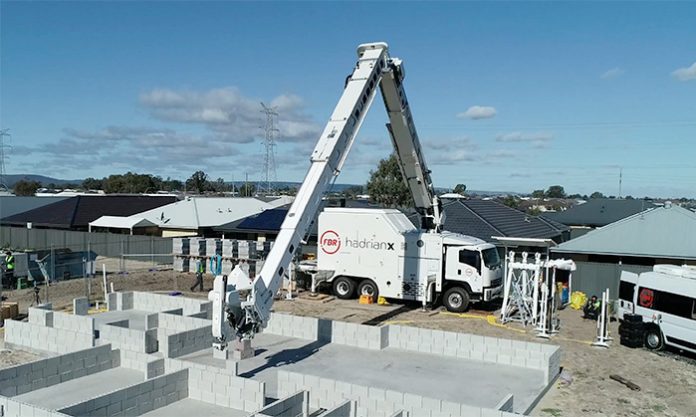Creative minds in the construction industry have several new tricks up their sleeves that could turn heads in 2024 and beyond.
Others are further developments of concepts seen before; some are really different.
Let’s start with robots.
Robots have been around for some time, offering the potential for high efficiency in repetitive processes while improving site safety. Each year they take on bigger jobs. Laying blocks is a perfect example.
“Humans have been laying bricks in the same way for the past 6,000 years. Until now,” proclaims Australian robotic designer and manufacturer FBR.
The company has developed and successfully demonstrated a block laying machine called Hadrian X in several housing developments Down Under.
Hadrian X is big, powerful and semi-autonomous. Its 105-foot-long telescopic arm follows 3D computer assisted design models controlled remotely by tablet using proprietary software. It can lay over 300 blocks per hour, the equivalent of almost 4,000 square feet of standard block in a day’s work.

“When we started out on the development of the Hadrian machine, the world was feeling the cyclical pain of construction labour constraints across a number of areas,” said FBR managing director and CEO Mike Pivac in his 2023 shareholders’ address. “At that time, manual bricklaying was the third or fourth largest constraint to building and construction firms globally. In 2023, that became number one.”
Interest has quickly developed in the United States. A distributor has been appointed in Florida and three new orders for Hadrian X units are in hand for delivery expected early this year.
If building a dry stone wall from boulders is preferred, there’s a robot for that too.
A team from the ETH Zurich Research Institute customized a 12-ton Menzi Muck M545 walking excavator into an automatic robotic device called HEAP, short for Hydraulic Excavator for an Autonomous Purpose.
Using a 3D scan of the site and the locations of multi-ton boulders, HEAP can lift each rock, measure its weight, centre of gravity and shape, and then determine the best location for that rock in a predesigned dry stone wall. In demonstrations, researchers say that HEAP was able to build a permanent 20 foot retaining wall over 200 feet long without any mortar.
Building from the ground up is only one part of the construction industry story.
Attention is increasingly focussed on reducing embodied carbons, making retrofits to existing buildings important. Retrofits can eliminate the need to demolish and rebuild while concurrently reducing operational carbon emissions by improving the energy efficiency of a structure’s envelope.
All-in-one insulated exterior façade panels are already on the market, addressing the matter of conductive heat flow. However, equally important are the Interior Air Quality issues in a highly insulated building.
Hydronic Shell Technologies believes it may have an answer to both.
The start-up based in New York City has developed patented prefabricated exterior panels that incorporate insulation, heating, cooling and ventilation into one façade element that the company says can reduce energy use by as much as 90 per cent.
“The Hydronic Shell prefabricated façade panel includes all elements necessary to deliver complete heating, cooling and ventilation to each unit in a multi-unit residential building, or to handle the perimeter loads in other building types such as offices, schools and warehouses,” the company says. “The piping and ductwork in each panel connects to vertical risers to form a complete HVAC system with all components enclosed within the new façade.”
Company founder David Goldstein has likened the Hydronic panels to a blanket that can be heated and cooled using portions of the building’s existing HVAC infrastructure by running hot and cold water through pipes in the façade. New replacement windows have built-in ventilation, which is important when buildings become “tight.”
A seven-storey low-income public housing apartment building in Syracuse, N.Y., will serve as a pilot project this spring. Because of their modular construction, it is expected tenants can remain in their units while the new exterior façade is installed.
John Bleasby is a Coldwater, Ont.-based freelance writer. Send comments and Inside Innovation column ideas to editor@dailycommercialnews.com.



Recent Comments
comments for this post are closed